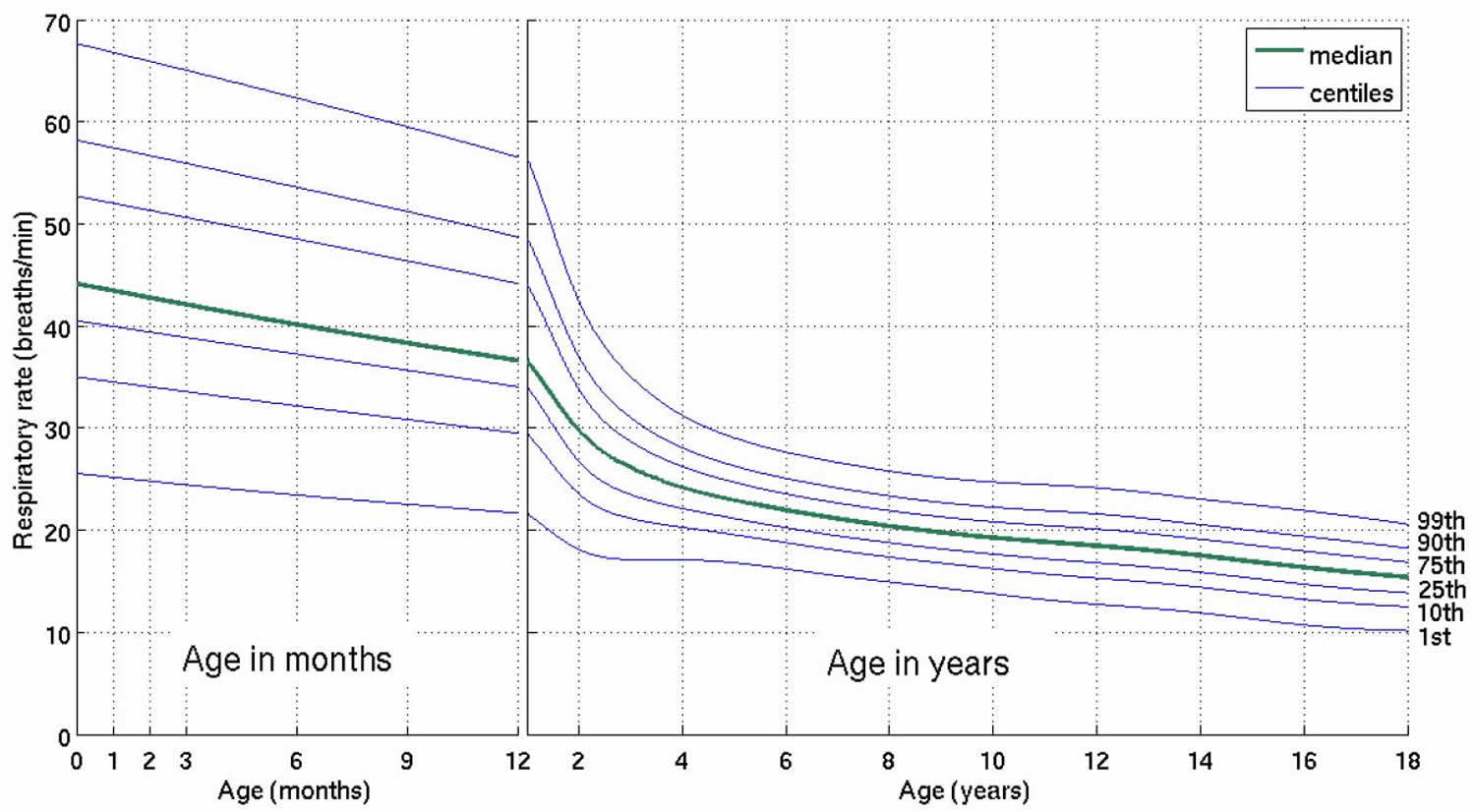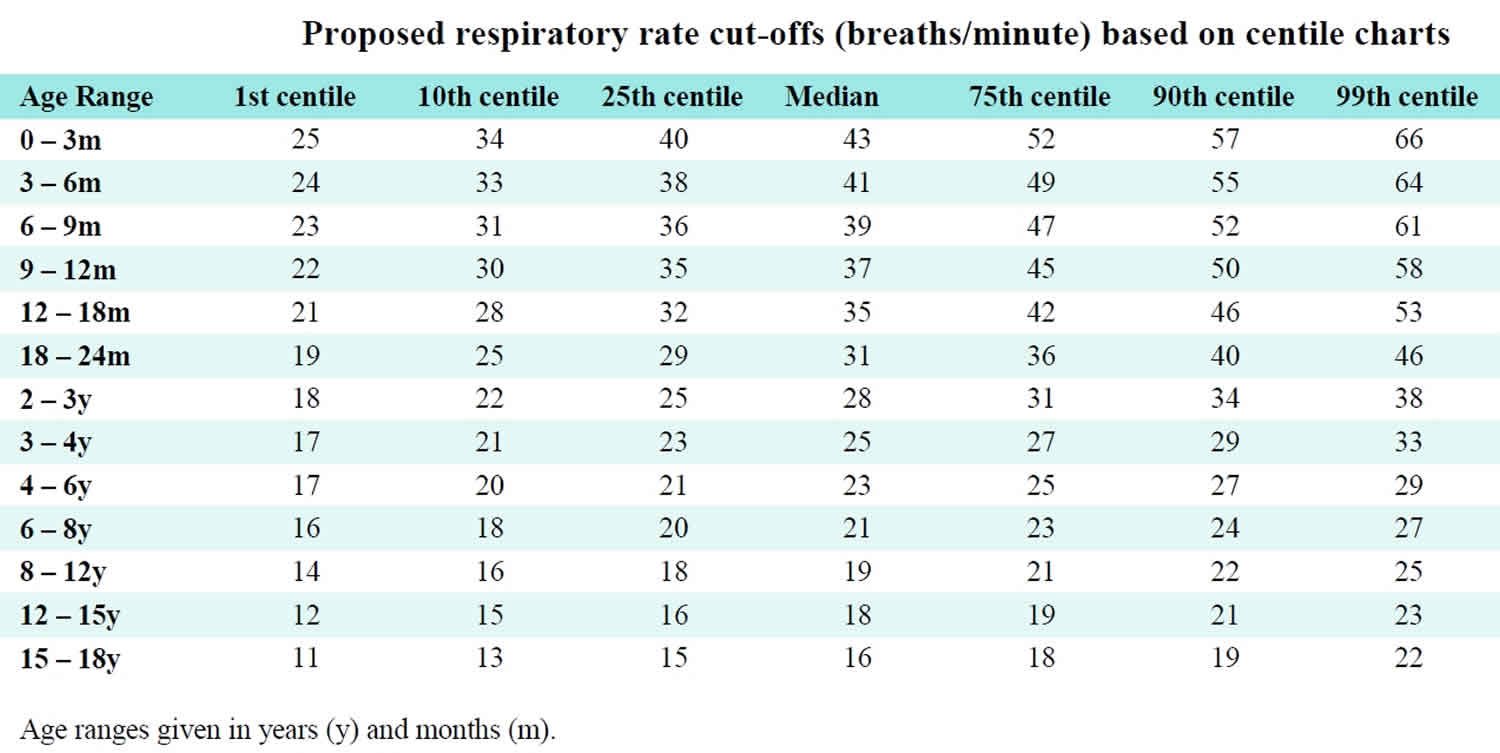What is a normal respiratory rate
Respiratory rate is the the number of breaths per minute. Your respiratory rate is highly regulated to enable cells to produce the optimum amount of energy at any given occasion. A complex nervous system of nerve tissues regulates the rate of oxygen inflow and carbon dioxide outflow and adjusts it accordingly in conditions that tend to derange partial gas pressures in blood. Respiration is a process involving the brain, brainstem, respiratory muscles, lungs, airways, and blood vessels. All these structures are involved structurally, functionally and regulatory to respiration.
- Normal respiratory rate for adults: 12 to 20 breaths per minute
- Normal respiratory rate for newborn: see Tables 1 and 2 below
- Normal respiratory rate for infants: see Tables 1 and 2 below
- Normal respiratory rate for children: see Tables 1 and 2 below
Normal respiratory rate changes with age; 12 to 20 respirations per minute (breaths per minute) is the normal range for a resting adult 1. However, in the elderly population, an individual with more than 28 respirations/minute is deemed tachypneic 2. Children have a higher respiratory rate than adults. The median respiratory rate in the first two years is reduced from 44 respirations/minute at birth to 26 respirations/minute during their second year of life 3.
Along with blood pressure, temperature, and pulse rate, respiratory rate is one of the vital signs routinely monitored in a clinical setting.
Alterations in normal respiratory rate are often a clinical manifestation of pathological conditions. These conditions induce changes in the previously mentioned feedback categories, and the resulting respiratory rate or volume change is an adjustment to the disease state. Metabolic acidosis states increase the tidal volume, while metabolic alkalosis has the opposite effect in ventilation, decreasing the respiratory rate. Interstitial diseases that change the mechanical input to the respiratory center lead to rapid breathing rate. Congestive heart failure has the same effect by stimulating J-receptors with the mechanism that was described earlier. Higher cortical centers can be affected by an increase in intracranial pressure, e.g., in a patient with head trauma or by pain in a patient with a rib fracture, resulting in an increased respiratory rate. The opposite effect on higher centers will be observable in an individual who has taken CNS depressant substances.
Figure 1. Normal respiratory rate in children from birth to 18 years of age
Footnote: The chart demonstrates the decline in respiratory rate from birth to early adolescence, with the steepest decline apparent in infants during the first two years of life. The median respiratory rate decreases by 40% in these two years (44 breaths/minute at birth to 26 breaths/minute at two years).
[Source 3 ]Table 1. Normal respiratory rate and heart rate in children from birth to 18 years of age (proposed respiratory rate cut-offs (breaths/minute) based on centile charts in Figure 1)
Table 2. Normal respiratory rate and heart rate in children from birth to 18 years of age
[Source 4 ]- Chourpiliadis C, Bhardwaj A. Physiology, Respiratory Rate. [Updated 2019 Jan 28]. In: StatPearls [Internet]. Treasure Island (FL): StatPearls Publishing; 2019 Jan-. Available from: https://www.ncbi.nlm.nih.gov/books/NBK537306[↩]
- Rodríguez-Molinero A, Narvaiza L, Ruiz J, Gálvez-Barrón C. Normal respiratory rate and peripheral blood oxygen saturation in the elderly population. J Am Geriatr Soc. 2013 Dec;61(12):2238-40[↩]
- Fleming S, Thompson M, Stevens R, et al. Normal ranges of heart rate and respiratory rate in children from birth to 18 years of age: a systematic review of observational studies. Lancet. 2011;377(9770):1011–1018. doi:10.1016/S0140-6736(10)62226-X https://www.ncbi.nlm.nih.gov/pmc/articles/PMC3789232[↩][↩]
- Fleming S, Thompson M, Stevens R, et al. Normal ranges of heart rate and respiratory rate in children from birth to 18 years of age: a systematic review of observational studies. Lancet. 2011;377(9770):1011–1018. doi:10.1016/S0140-6736(10)62226-X https://www.ncbi.nlm.nih.gov/pmc/articles/PMC3789232/bin/NIHMS54714-supplement-Web_Appendix.pdf[↩][↩]








